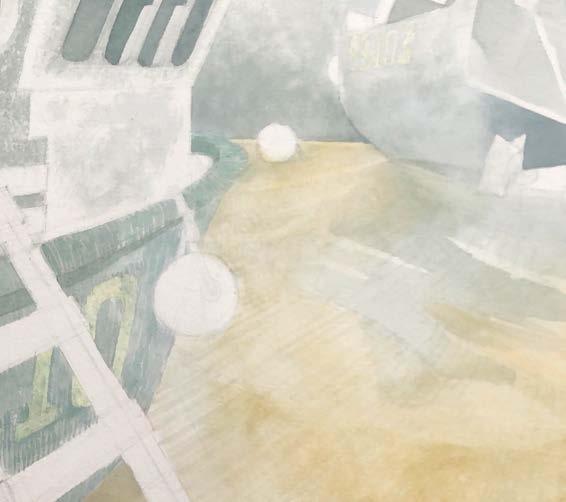
3 minute read
Demo
DEMO Paint LIKE RAVILIOUS
Eric Ravilious’ intricately cross-hatched watercolours recall his training as a wood engraver. In this exercise, DAVID CHANDLER employs his method to explore contour and texture

1 2


3 4

David's materials
•Watercolours Payne’s Grey, Phthalo Blue, Forest Green, Yellow Ochre, Burnt Sienna, Lemon Yellow, Vermilion and Chinese White •Brushes Round brushes, sizes 2, 4, 8 and 12; short flat brush, 3/4” •Paper Cold-pressed 300gsm watercolour paper •3H pencil •Mixing palette •Water pot •Scalpel 1 Examine the source From the rural idylls of his early years to his wartime airplanes and battleships, Eric Ravilious’ intricately crosshatched watercolours recall his training as a wood engraver. By the time of 1940's Submarines in Dry Dock, it was still the “dot and speck and dash and dab” (as his biographer, James Russell, called it) of the wood engraving that informed his work. Smeaton’s Pier in St Ives seemed ideal. Like Submarines..., I have attempted to channel the viewer’s gaze between the beached fishing boats and towards the brickwork of the pier. Start by drawing your design lightly onto the paper with a 3H pencil. If your boats have registration codes, mask these with masking fluid.
2Draw lightly Rounded, mechanical forms like Ravilious’ submarines were on my mind for this painting and the beached fishing boats at boat on the left, I scrubbed the Payne’s Grey on using a dry size 4 round brush. With the same brush, I drew parallel lines across the sea (top right corner) and radiating lines over the sand in the foreground.
3Block in greys With the size 8 round brush, paint dilute Payne’s Grey on any surfaces that will be dark or in shadow – in my example, this was the pier, the coastline, the boats and the shadow under the boat on the right. On the cabin of the 4 Introduce detail With a dry size 4 round brush and a scrubbing, dotting stroke, darken shadows where necessary on the boats and on the pier. I’ve also added fine detail on the distant coastline using the size 2 round brush. Then, once the Payne’s Grey is dry, paint the sky with dilute Phthalo Blue using the size 4 round brush.

5 6


Top tip Shape was important to Ravilious, so a carefully executed drawing is key here 7 8

5Deepen shadows Adjust the values where necessary. I added more Payne’s Grey to the boat on the left, more Phthalo Blue to the sky, and a mix of the two to the boat on the right.
6Add new colours With a round size 12 brush dipped in dilute Yellow Ochre, paint the sand in the foreground. Allow the colour to fade as you move towards the sea. When this is dry, darken the foreground by scrubbing and dabbing on more of the same colour with a dry size 4 brush. Paint the hull of one of the boats with thin strokes of the size 2 round brush in Forest Green. 7 Cross contours With the size 2 round brush, crosshatch the hull by placing more strokes of Forest Green at 90 degrees to the previous ones. With the same brush, paint the boat on the right with thin strokes of Phthalo Blue, following the contours of the hull. Add ripples of Burnt Sienna and Phthalo Blue where the water turns transparent on the shore. Use the No.4 round brush to darken the shadows under the boats with dilute Burnt Sienna, then dry the brush and scrub more onto the foreground. My lifebuoy is pale Vermilion and the fishing floats are pale Vermilion and Lemon Yellow. The seaweed-covered rope is Forest Green. Take care not to make your colours too bright. Darken the hulls, if necessary, and peel off the masking fluid. Tidy up any uneven letters or numbers with a scalpel blade and Chinese White. Use the size 2 round brush to paint brickwork and shadows with Payne’s Grey. I added radiating lines on the sand in pale Burnt Sienna. This is an edited extract from David’s new book, Tate: Master Watercolour, published by Ilex Press. www.octopusbooks.co.uk











